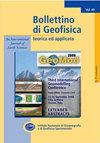Purported Precursors: Poor Predictors
IF 0.7
4区 地球科学
Q4 GEOCHEMISTRY & GEOPHYSICS
引用次数: 0
Abstract
Author(s): Mulargia, F; Gasperini, P; Lolli, B; Stark, PB | Abstract: © 2015 - OGS. The destructive 2009 L'Aquila and 2012 Emilia-Romagna earthquakes led the Italian Dipartimento della Protezione Civile (DPC) to fund nine research groups to investigate seismic precursors. Three research groups produced testable predictions by the DPC deadline of May 31, 2013, based on: 1) radon in a well in Friuli, 2) temperature, flow, CO2 flux, and other variables measured in wells in Emilia-Romagna, and 3) an Artificial Neural Network (ANN) algorithm applied to seismicity. We evaluated the geochemical precursors by comparing their predictions to an equal number of predictions at the same locations and with the same individual and total durations as the actual predictions, but at random times. This approach avoids modelling the seismicity, so the accuracy of the predictions is not influenced by the accuracy of any seismicity model. Neither set of geochemical precursors succeeds significantly better than the random predictions. ANN, on the other hand, did not predict any events large enough to affect public safety.所谓的先兆:糟糕的预测者
作者:Mulargia, F;Gasperini P;Lolli, B;摘要:©2015 - OGS。2009年的拉奎拉地震和2012年的艾米利亚-罗马涅地震导致意大利民事保护部门(DPC)资助了9个研究小组来研究地震前兆。在DPC截止日期(2013年5月31日)之前,三个研究小组基于以下因素做出了可测试的预测:1)Friuli井中的氡含量,2)Emilia-Romagna井中测量的温度、流量、CO2通量和其他变量,以及3)应用于地震活动的人工神经网络(ANN)算法。我们通过将地球化学前体的预测与相同地点的相同数量的预测进行比较来评估地球化学前体,这些预测具有与实际预测相同的个体和总持续时间,但在随机时间。这种方法避免了对地震活动性进行建模,因此预测的准确性不受任何地震活动性模型准确性的影响。两组地球化学前体都没有比随机预测成功得多。另一方面,人工神经网络没有预测到任何大到足以影响公共安全的事件。
本文章由计算机程序翻译,如有差异,请以英文原文为准。
求助全文
约1分钟内获得全文
求助全文
来源期刊

Bollettino Di Geofisica Teorica Ed Applicata
地学-地球化学与地球物理
自引率
0.00%
发文量
0
审稿时长
>12 weeks
期刊介绍:
The "Bollettino di Geofisica Teorica ed Applicata" is an international open access journal dedicated to the publication of original papers dealing with Deep Earth Geophysics, Near Surface Geophysics, Exploration Geophysics, Borehole Geophysics, Geodynamics and Seismotectonics, Seismology, Engineering Seismology, Geophysical Modelling, Geodesy, Remote Sensing, Seismic and Geodetic Networks, Oceanography, and their application in the fields of Energy, Natural Resources, Environment and Climate, Policies and Regulations, Risk and Security, Technological Development.
 求助内容:
求助内容: 应助结果提醒方式:
应助结果提醒方式:


